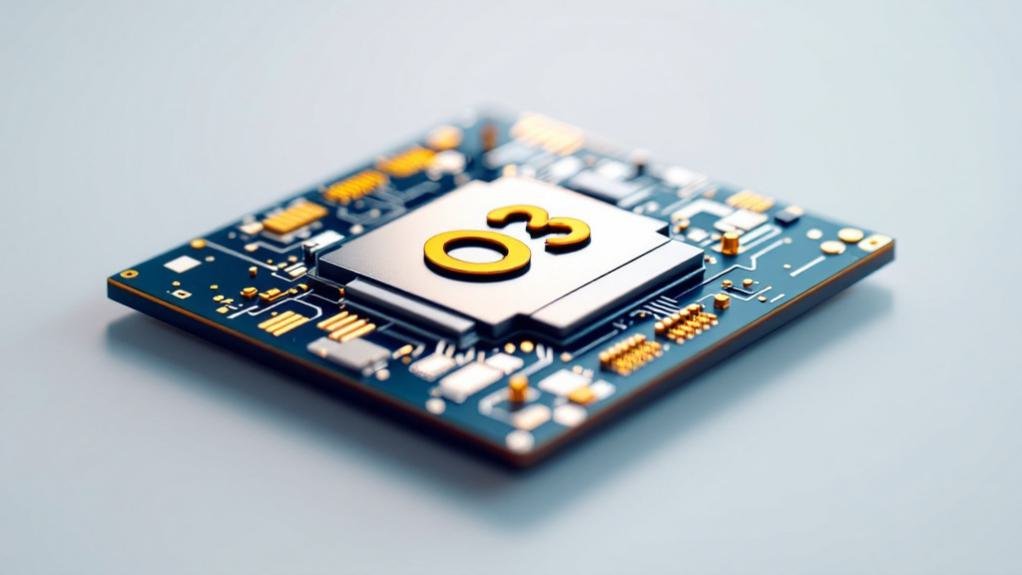OpenAI’s O3 model represents a paradigm shift in artificial intelligence, introducing groundbreaking advancements in reasoning, computational efficiency, and scalability. As an upgrade to prior models, the O3 demonstrates unparalleled capabilities, including a large token context window, high performance on mathematical benchmarks, and transformative applications across industries.
What Is OpenAI’s O3 Model?
The OpenAI O3 model is a next-generation AI system designed to revolutionize problem-solving through deep learning-guided program synthesis. This advanced architecture enables the model to simulate reasoning patterns, dynamically generate solutions, and handle complex computational tasks. Its large token context window ensures the processing of extensive datasets without loss of coherence.
Learn More: Explore OpenAI’s advancements in token handling for a deeper dive into how O3’s architecture excels in language processing.
Technical Architecture and Performance Benchmarks
What Are the Key Features of OpenAI O3?
Design Highlights
- Scalable Performance: The O3 achieves impressive benchmarks, demonstrating exceptional reasoning and problem-solving skills.
- Advanced Architecture: Features deep learning-guided program synthesis and an adaptive compute system for optimized resource utilization.
- High Context Retention: Processes extensive token sequences in a single query, ensuring unparalleled depth in language understanding.
- Dynamic Costing: Pricing varies across usage scenarios, making it flexible for diverse applications.
Performance Benchmarks
- Mathematics: Demonstrated top-tier performance on rigorous mathematical benchmarks.
- Software Engineering: Showcased significant improvements in program synthesis capabilities.
- Competitive Programming: Exhibited strong problem-solving abilities in coding scenarios.
Related: Discover the business benefits of AI advancements.
Simulated Reasoning Capabilities
In accordance with OpenAI’s latest innovations, o3’s simulated reasoning capabilities represent a fundamental shift in AI problem-solving methodology. The system’s cognitive models leverage private chain of thought mechanisms to evaluate potential solutions, achieving remarkable performance improvements across complex tasks. You’ll find that o3’s simulated reasoning approach moves beyond traditional pattern recognition, instead employing multiple systems for understanding and solution generation. The O3-mini variant provides adaptable processing speeds for diverse applications. This development took five years initially to progress from 0% to 5% on ARC AGI testing.
The platform’s enhanced capabilities are evident in its benchmark performances:
- Scores of 75.7% and 87.5% on ARC-AGI benchmarks under varying computing conditions
- Superior performance in coding, mathematics, and scientific problem-solving
- Improved accuracy in physics and advanced mathematics through step-by-step reasoning
- Enhanced contextual understanding for synthetic data generation
You’re looking at a system that doesn’t just process information but simulates human-like reasoning patterns. This advancement positions o3 as a significant step toward AGI, with practical applications in research and academic fields. The platform’s ability to scale at inference time guarantees real-time responses to complex tasks, while its deliberate approach to problem-solving sets new standards in AI reasoning capabilities.
Cost Analysis and Pricing Structure

The sophisticated reasoning capabilities of o3 come with notable cost implications that warrant careful consideration. While pricing details aren’t officially published, current estimates indicate a significant cost variance between the model’s variants. You’ll find the o3-mini offering a more cost-effective solution, while the full version’s high-compute mode can reach thousands of dollars per task. DeepSeek demonstrates that comparable performance can be achieved at just $0.14 per million tokens.
Early benchmarks suggest the performance per dollar is substantially improved compared to O1 models. Understanding the cost trends is important for implementation planning. The base low-compute mode is estimated at $20 per task, but you’ll need to budget substantially more for high-compute operations, potentially reaching $3,500 per task. However, following the pricing strategies observed with GPT-4, which has seen a 99% cost reduction over two years, you can expect o3’s prices to decrease as the technology matures.
The model’s pricing structure mirrors previous OpenAI releases, offering different performance tiers. While the initial costs may seem steep, particularly for high-compute applications, market indicators suggest a likely downward trajectory. Considering that early adoption costs will likely decrease substantially over time, you’ll need to weigh the performance benefits against current budget constraints.
Testing Program and Availability Details
OpenAI’s testing program for o3 follows a carefully structured approach, with access initially restricted to safety researchers through an invitation-based system. The invitation period will continue until January 10, 2025. The testing methodology emphasizes thorough evaluation under various computational conditions, with the model demonstrating impressive benchmarks including a 75.7% score on ARC-AGI in low-compute scenarios and 87.5% in high-compute settings.
The announcement timing during the 12 Days of OpenAI event strategically maximizes media exposure and public interest. The all-encompassing testing program includes these key components:
- Variable computational settings ranging from 6x to 1024x compute power to assess performance scalability
- Benchmark evaluations across mathematics, science, and coding tasks, including a 96.7% score on the American Invitational Mathematics Exam
- SWE-Bench Verified testing yielding a 71.7% score, establishing new standards in coding capabilities
- Phased release strategy with access restrictions to guarantee safety and effectiveness
o3, our latest reasoning model, is a breakthrough, with a step function improvement on our hardest benchmarks. we are starting safety testing & red teaming now. https://t.co/4XlK1iHxFK
— Greg Brockman (@gdb) December 20, 2024
You’ll need to wait until late January 2025 for broader access to o3-mini, with the full o3 model’s release timeline yet to be announced. This controlled rollout allows OpenAI to refine the model through extensive testing while managing potential risks and ensuring peak performance across various applications.
Is O3 a Step Towards AGI?
OpenAI’s O3 model is being heralded as a monumental step forward on the path to achieving Artificial General Intelligence (AGI). Unlike narrow AI models that specialize in specific tasks, O3 exhibits advanced reasoning, adaptability, and learning capabilities that align closely with AGI principles.
How O3 Advances AGI Development
- Broad Applicability: With its ability to process and synthesize complex information, O3 sets new standards for machine adaptability.
- Human-Like Reasoning: The multi-step reasoning and problem-solving mechanisms closely mimic human cognitive processes, a core requirement for AGI.
- Benchmark Leadership: Its performance on tests like ARC-AGI and the American Mathematical Olympiad demonstrates progress toward the generalization needed for AGI.
Why This Matters
The prospect of AGI promises a future where machines can seamlessly adapt to and solve diverse problems across domains. O3’s groundbreaking architecture and capabilities position it as a crucial building block in this transformative journey.

Building on the rigorous testing program, rapid advancements in o3’s development signal transformative changes ahead for AI technology. With an impressive 88% performance on the ARC-AGI benchmark test, o3’s capabilities suggest significant progress toward AGI Predictions, though experts like François Chollet maintain cautious optimism about declaring true AGI achievement. In alignment with OpenAI’s commitment to safety, the model’s restricted access policy ensures thorough security analysis before wider deployment. The integration of deliberative alignment techniques enhances the model’s ability to distinguish between safe and unsafe prompts with unprecedented accuracy.
| Impact Area | Current State | Future Innovations |
|---|---|---|
| Technical Performance | 88% ARC-AGI score | Enhanced reasoning systems |
| Cost Structure | $3,500/query | Expected dramatic reduction |
| Application Scope | Limited release | Cross-industry expansion |
| Environmental Impact | Resource-intensive | Sustainability optimization |
| Model | Score (Semi-Private Eval) | Score (Public Eval) | Type 1 | Type 2 |
|---|---|---|---|---|
| O3 (coming soon) | 75.7% | 82.8% | CODE | PAPER |
| Jeremy Berman | 53.6% | 58.5% | CODE | PAPER |
| MARA (BARC) + MIT | 47.5% | 62.8% | CODE | PAPER |
| Ryan Greenblatt | 43% | 42% | CODE | PAPER |
| O1.preview | 18% | 21% | CODE | |
| Claude 3.5 Sonnet | 14% | 21% | CODE | |
| GPT40 | 5% | 9% | CODE | |
| Gemini 1.5 | 4.5% | 9% | CODE |
You’ll see o3’s influence extending across multiple sectors, from revolutionizing mathematics and coding to transforming creative writing and real-time problem-solving capabilities. While initial costs remain high at $3,500 per query, you can expect significant price reductions following patterns similar to GPT-4’s cost evolution. The model’s rapid development cycle outpaces traditional large language models, suggesting accelerated improvements in AI capabilities. This advancement trajectory positions o3 at the forefront of next-generation AI systems, though environmental considerations and workforce implications will require careful balance as adoption increases.
Frequently Asked Questions
How Does O3’s Energy Consumption Compare to Other AI Models?
Using GPT-4’s massive 62.3M kWh consumption as reference, you’ll find O3 demands even more power, with its advanced version using 172x more energy than its basic model, challenging energy efficiency standards.
Can O3 Be Run Offline or Does It Require Constant Internet Connection?
You’ll need a constant internet connection to use O3, as it doesn’t support offline capabilities. Its architecture and high-compute requirements demand continuous connectivity for processing and inference operations.
What Security Measures Are in Place to Prevent Misuse of O3?
You’ll find robust user access controls and embedded ethical guidelines through deliberative alignment, limiting initial release to cybersecurity researchers while preventing harmful outputs and unauthorized model deployment.
Will O3 Be Available for Educational Institutions at Discounted Rates?
You’ll need to wait for official announcements regarding educational discounts, as there’s no confirmed pricing structure. While institutional partnerships may develop, specific discount rates aren’t currently available for o3.
How Does O3 Handle Tasks in Languages Other Than English?
While 95% of reported data focuses on English tasks, you can expect multilingual capabilities through automatic language detection, though specific performance metrics in non-English languages remain largely undocumented.
Conclusion
You’ll find O3’s pricing predictably positions it as a premium product, with performance parameters proving particularly powerful compared to current competitors. Market metrics maintain that monthly costs could create considerable constraints for smaller companies, yet the technical testing tells a compelling tale of transformative capabilities. Your deployment decisions should deliberately weigh these distinct dynamics as O3’s development drives dramatic shifts in enterprise AI adoption.

